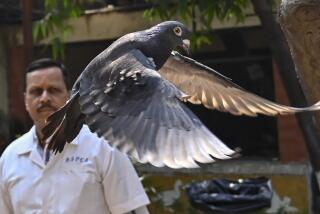Animal Activists Arrested at Pigeon Shoot : Protest: 85 held for freeing caged birds or rescuing wounded ones. Crowd cheers whenever police seize demonstrators.
- Share via
HEGINS, Pa. — Eighty-five people were arrested Monday as an estimated 500 animal-rights activists protested a pigeon-shooting contest that is a 58-year-old Labor Day tradition in this small Pennsylvania mountain town 50 miles northeast of Harrisburg.
The protesters, who flocked in from around the country, have helped to make civil disobedience a regular feature of this end-of-summer rite.
Since 1986, animal-protection groups have tried to stop the daylong event. They object not only to the killing of about 5,000 pigeons but also to the use of local children as “trap boys,” who retrieve dead pigeons and break the necks of the injured ones.
Two years ago, activists were dealt their biggest blow when the state Legislature voted overwhelmingly not to ban such shoots. An appeal to Democratic Gov. Robert P. Casey to stop the Hegins shoot, made last year by the Pennsylvania-based Animal Rights Mobilization, also failed.
Forty-five other states ban such live animal shoots.
This year, the New York-based group Fund for Animals offered to offset the costs of holding a Labor Day shoot of clay pigeons instead.
Besides the protesters who picketed just outside the event’s entrance, about 11,000 spectators crowded into the community park at a cost of $5 each, ostensibly to picnic and watch 250 contestants with single- and double-barrel shotguns shoot the pigeons, which were released from boxes 30 feet away.
But the crowd’s biggest cheers came whenever state troopers on foot and on horseback ran down protesters who bolted across the fields, picking up injured birds and releasing others held in the traps.
The few self-proclaimed “pigeon liberators” who eluded troopers carried injured birds to one of several stations set up to treat them or to perform euthanasia through injection, depending on the extent of the birds’ injuries. Those protesters posed as contestants or broke through a plastic mesh fence bordering the event.
During breaks between the pigeon releases, protesters chanted: “Big guns, small minds!” and spectators’ chanted: “Save a pigeon, shoot a protester!”
But, by afternoon, the buses that carried nearly half of the protesters here from a weekend animal-rights conference in Harrisburg, the state capital, began to depart, and the remaining protesters seemed more interested in going to the makeshift courthouse in the local high school to post bail for friends being arraigned by three district justices.
Most of those arrested were charged with theft--each pigeon cost the shoot’s organizers $5--receipt of stolen property and “defiant” trespassing, the fine or bail for which was set at $343 total. But those who released pigeons from traps faced tougher theft and trespassing charges and a bail set at $5,000.
One protester who leaped on top of a 12-year-old “trap boy” was charged with felony assault.
The two most prominent persons arrested were the co-founders and current leaders of the Washington, D.C.-based People for the Ethical Treatment of Animals, Ingrid Newkirk and Alex Pacheco. He carried a crate full of 20 birds above his head while fleeing from police officers, before falling, breaking the cage and freeing the pigeons.
Protesters from PETA, which calls itself the nation’s largest animal-protection group, with more than 300,000 members, joined those from a coalition of other organizations, including the host group, Fund for Animals, for the weekend Harrisburg conference, an annual conference normally held in Houston. This year, classes in passive resistance to police officers were held in preparation for the protest.
Heidi Prescott, a spokeswoman for the host group, predicted that the pigeon shoot would be shut down eventually. “It’s a barbaric event,” she said.
Last year, the shoot raised $20,000 for local charities, said the event’s chief organizer, Robert Tobash. Twenty-seven people were arrested that year when state troopers had difficulty controlling the crowd.
State police Maj. James Hazen, in a press conference during this year’s event, refused to disclose how many troopers had been brought into the farming and coal-mining town of 1,100, except to say it was more than 100.
Despite the disruptions, Tobash proclaimed the shoot a success, predicting a $26,000 profit. Tobash said the protesters only help the shoot every year.
“When they came out (in 1986) and said they would stop the shoot, we started getting volunteers and spectators. They brought the community together,” Tobash said.
Residents seemed to agree. “I don’t care about pigeons, but these guys are just out to get hunting done with. And, when they are done, they will go after the guns,” said Steve Hazelton, a maintenance worker.
But the protesters vowed to return and stop the shoot. “It’s the most disgusting event in the nation. This shows that we will not go away,” said PETA spokesman Jenny Woods. “Being a tradition does not make something right.”
More to Read
Sign up for Essential California
The most important California stories and recommendations in your inbox every morning.
You may occasionally receive promotional content from the Los Angeles Times.










